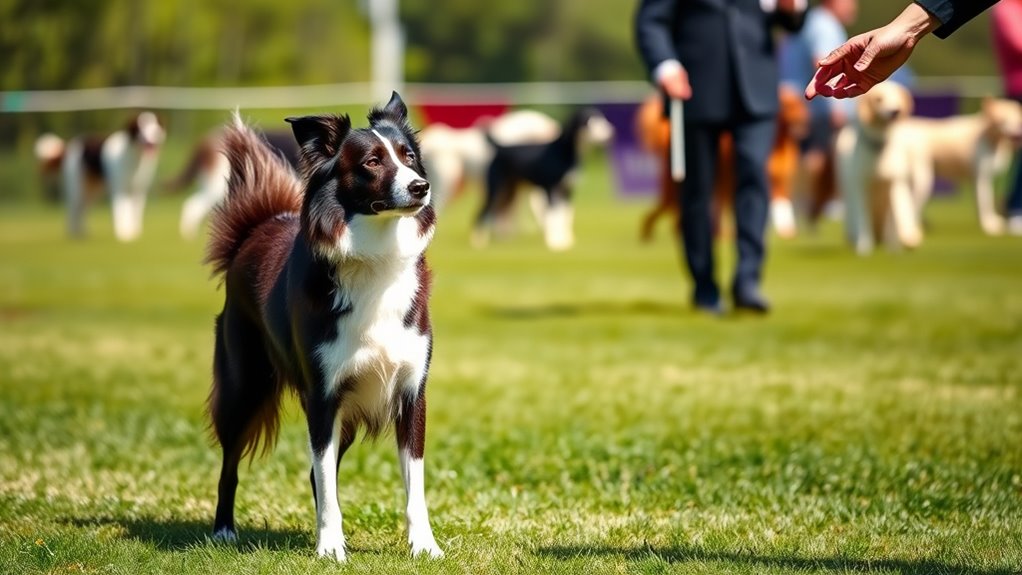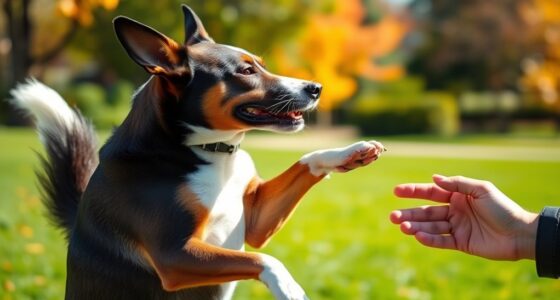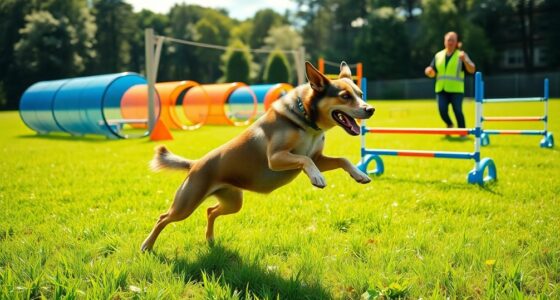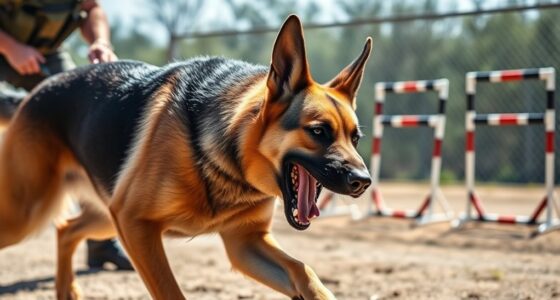To excel in competitive obedience trials, first master the rules and standards, including equipment regulations and breed-specific expectations. Build a strong foundation with basic commands, practicing precise timing and consistency. Incorporate distractions gradually to mimic ring conditions and develop focus. Work on pattern drills, handler-dog communication, and timing to improve response reliability. Prioritize mental and physical preparation for both you and your dog. Keep refining these skills, and you’ll be well on your way to success—there’s always more to discover.
Key Takeaways
- Build a strong foundation with basic commands, consistency, and varied pattern drills to ensure reliable responses under pressure.
- Incorporate distraction training gradually to simulate ring conditions, enhancing focus and resilience during competition.
- Develop clear handler-dog communication using consistent cues, positive reinforcement, and timing for precise marking.
- Practice calming techniques, proper nutrition, and sleep routines to optimize performance and manage nerves on competition day.
- Stay updated on breed standards, equipment rules, and industry trends to ensure compliance and confidence in the ring.
Understanding the Rules and Standards of Competition
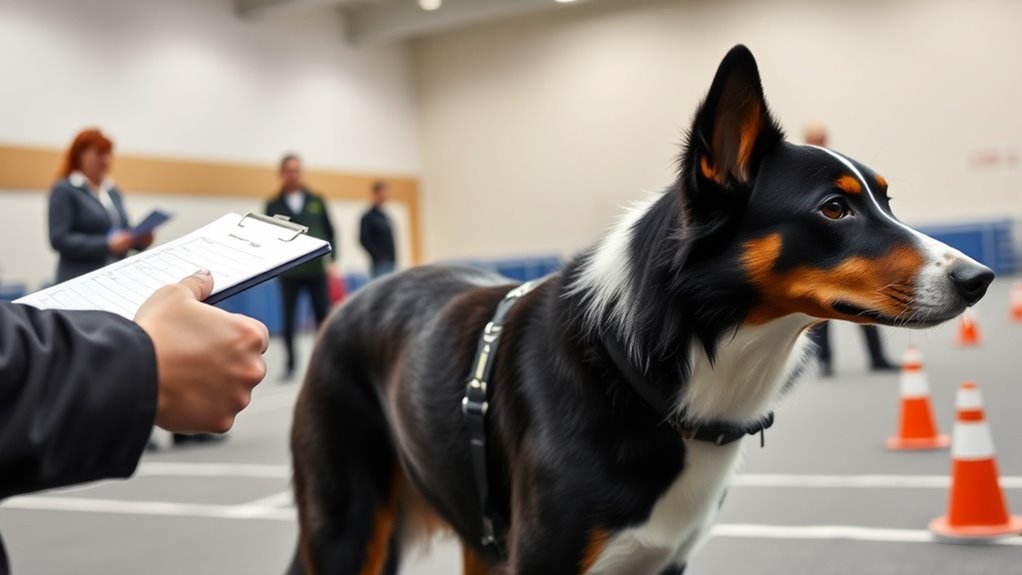
To succeed in obedience trials, you need a clear understanding of the rules and standards that govern the competition. This includes knowing the breeding standards that influence your dog’s behavior and temperament, ensuring your dog fits the ideal profile for obedience work. Equally important are the equipment regulations, which specify approved collars, leashes, and accessories allowed during the trial. Familiarize yourself with these guidelines to prevent disqualification or penalties. Understanding the standards helps you prepare your dog appropriately and ensures your training aligns with competition requirements. Staying informed about breed-specific expectations and equipment rules gives you confidence in the ring, allowing you to focus on executing commands flawlessly and demonstrating your dog’s training and discipline effectively. Additionally, reviewing industry trends can help you stay current with evolving standards and best practices in competitive obedience, including incorporating aesthetic organization systems for your training equipment and setup. Being aware of training equipment regulations ensures that your gear complies with official guidelines, reducing the risk of penalties during the competition. Moreover, understanding breed standards can assist in tailoring your training approach to your dog’s specific traits and strengths.
Building a Strong Foundation in Basic Commands
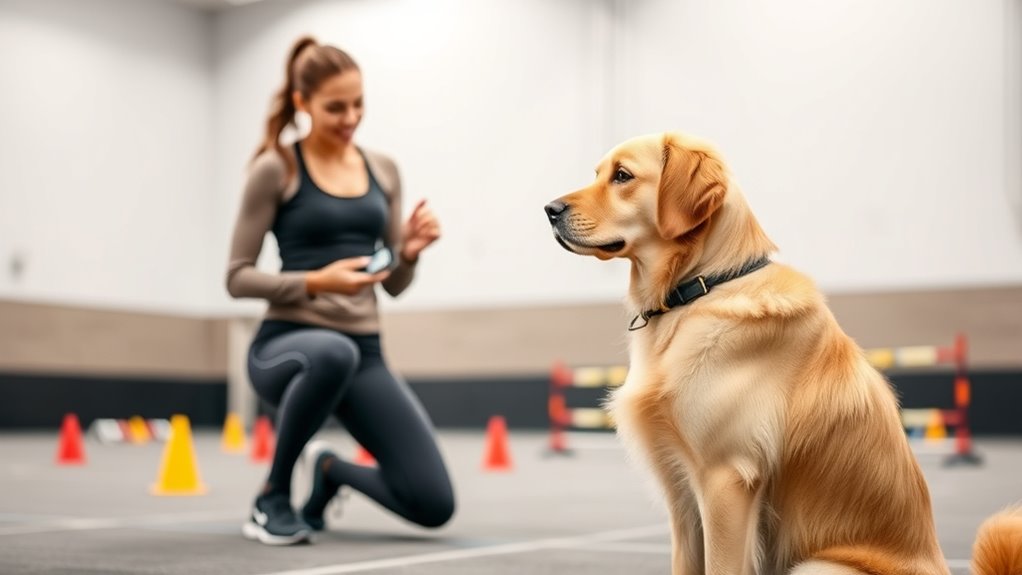
Establishing a solid foundation in basic commands is essential for your dog’s success in obedience trials. Focus on perfecting reward timing, so your dog understands exactly which behavior earns praise. Immediate rewards reinforce positive actions and speed up learning. Equipment selection is also vital; choose appropriate collars, leashes, and treats to keep training effective and comfortable for your dog. Consistent use of the same equipment helps your dog associate specific tools with training sessions, reducing confusion. Start with simple commands like sit, stay, and come, ensuring your dog masters these basics before progressing. Clear cues combined with timely rewards build confidence and reliability in your dog’s responses. A strong foundation in these fundamentals sets the stage for more advanced training later on.
Developing Precision and Consistency in Training
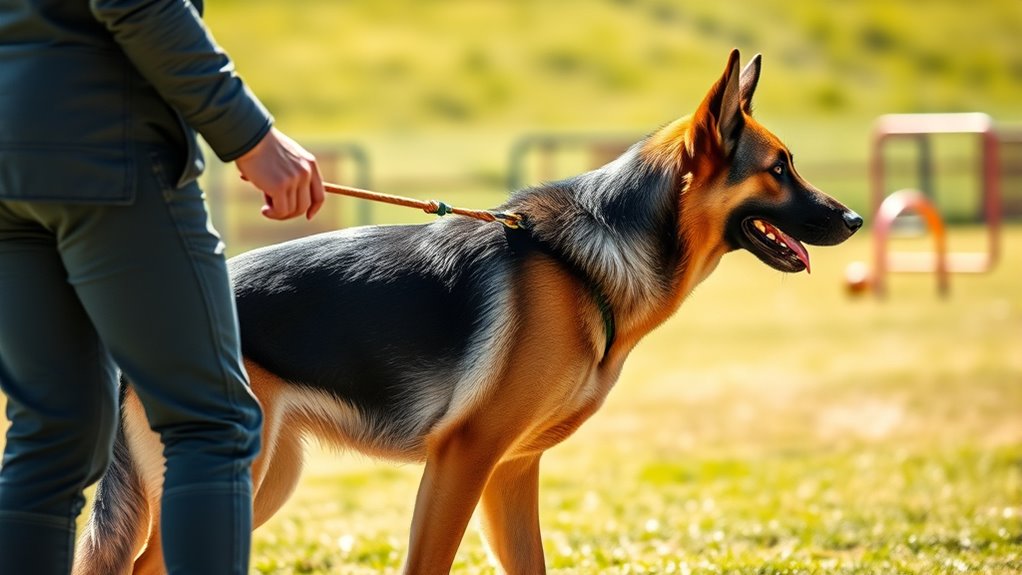
To develop precision and consistency, you need to focus on repetition to build reliability in your dog’s responses. You should also work on marking and timing to reinforce correct behavior at the right moment. Managing your dog’s focus and controlling distractions are essential to maintain consistency during training sessions. Incorporating calibration techniques can further enhance your ability to fine-tune your dog’s responses for competitive obedience. Additionally, understanding training methodologies can help you adapt your approach as your dog progresses. Practicing AI-driven feedback can help identify subtle areas for improvement. Emphasizing continuous learning ensures your training remains effective and aligned with the latest best practices. Engaging with best practices in training can provide valuable insights for ongoing development.
Repetition for Reliability
Repetition plays a crucial role in building reliability in obedience training because it helps your dog develop precise responses and consistency under various conditions. When preparing for obedience competitions, consistent practice ensures your dog reacts reliably during high-pressure moments. Repeating exercises across different environments and distractions solidifies their skills. To visualize this, consider the following table:
| Environment | Distraction Level | Response Accuracy |
|---|---|---|
| Quiet indoor | Low | High |
| Outdoors | Medium | Very high |
| Busy dog agility | High | Consistent |
This consistency is essential for success in obedience competitions, where your dog must perform flawlessly regardless of surroundings or distractions. Repetition trains your dog to respond reliably, making your teamwork more precise and confident. Incorporating varied training scenarios further enhances training consistency and prepares your dog for real competition environments. Additionally, regular practice ensures that your training remains effective over time. Employing data-driven strategies to monitor progress can also help identify areas needing improvement and optimize your training sessions. Furthermore, positive reinforcement techniques reinforce correct responses and encourage continued effort. Engaging in mindful training by maintaining focus and awareness during practice sessions can further improve your dog’s responsiveness and reliability.
Marking and Timing
Developing precision and consistency in training hinges on effective marking and timing. In dog agility and obedience, clear signals help your dog understand exactly when to act, improving overall performance. Use consistent cues, like a specific word or hand gesture, to mark the correct behavior immediately. Timing is vital; praise or reinforcement should follow instantly to reinforce learning. Accurate marking boosts handler confidence because you trust your cues, and your dog responds reliably. Practice marking and timing during drills to ensure your signals are crisp and well-timed. This consistency creates a strong foundation for more complex routines, helping both you and your dog perform with accuracy in the ring. Mastering this skill minimizes confusion and builds trust, leading to more precise obedience and agility work. Additionally, understanding the role of automation in training can help improve the efficiency and effectiveness of your training process.
Focus and Distraction Control
Focusing your dog’s attention amidst distractions is essential for consistent performance in obedience and agility. To achieve this, you must cultivate a calm demeanor in your dog and exude handler confidence. This helps your dog stay centered despite environmental chaos. Incorporate training exercises that simulate real trial distractions, gradually increasing difficulty to build focus. Use reinforcement techniques to reward sustained attention and calm responses. Consistent practice in varied settings strengthens your dog’s ability to ignore distractions and perform reliably. Remember, your calm demeanor influences your dog’s behavior, creating a secure environment for focus. Developing a calm demeanor and practicing patience are crucial in fostering your dog’s resilience. Additionally, understanding the importance of training methodology can further improve your dog’s focus and resilience in competitive scenarios. For optimal results, be mindful of cookie categories that support your training goals and ensure positive reinforcement. Incorporating training consistency into your routine reinforces your dog’s ability to maintain focus over time. Recognizing and managing distraction triggers during training sessions helps your dog learn to remain attentive in high-stakes environments.
Incorporating Distractions to Simulate Ring Conditions
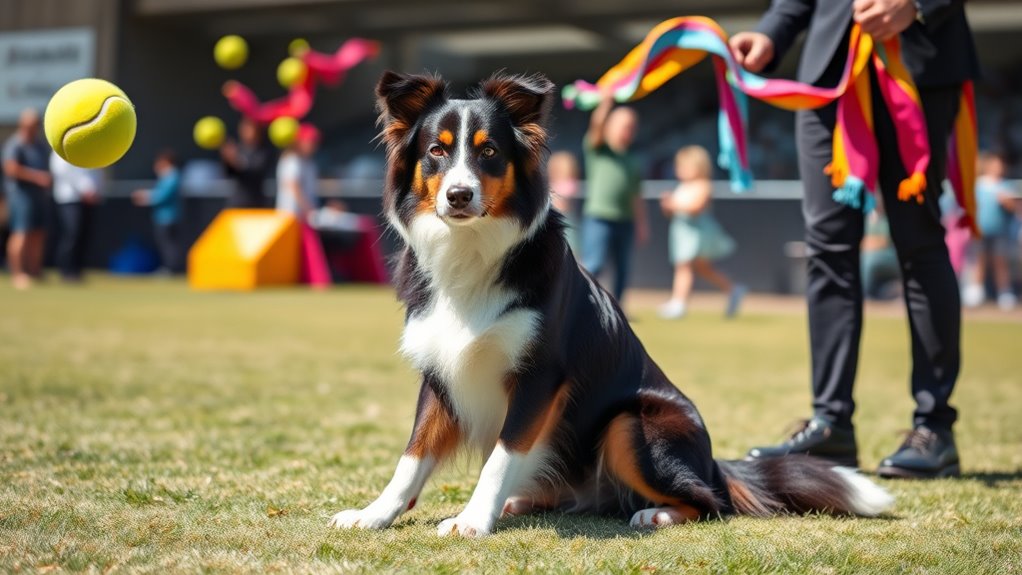
To prepare your dog for real ring conditions, you need to introduce distractions gradually during training sessions. Start with mild noise sensitivity triggers, like background chatter or distant sounds, and increase intensity as your dog remains focused. Incorporate scent work by hiding treats or toys in various locations to simulate the scent distractions found in the ring. These exercises help your dog become comfortable with unexpected stimuli and improve their focus amid distractions. Use positive reinforcement to reward calm behavior and attention. Remember, the goal is to build resilience without overwhelming your dog. As you progress, incorporating sensory toys that mimic real-world stimuli can further enhance your dog’s ability to stay focused. This approach aligns with the personal development techniques used to strengthen mental resilience. Incorporating distraction training regularly can lead to more consistent performance during competitions. Over time, these controlled distractions will help your dog stay composed under real ring conditions, making them more confident and responsive during competitions.
Practicing Pattern Drills and Sequences
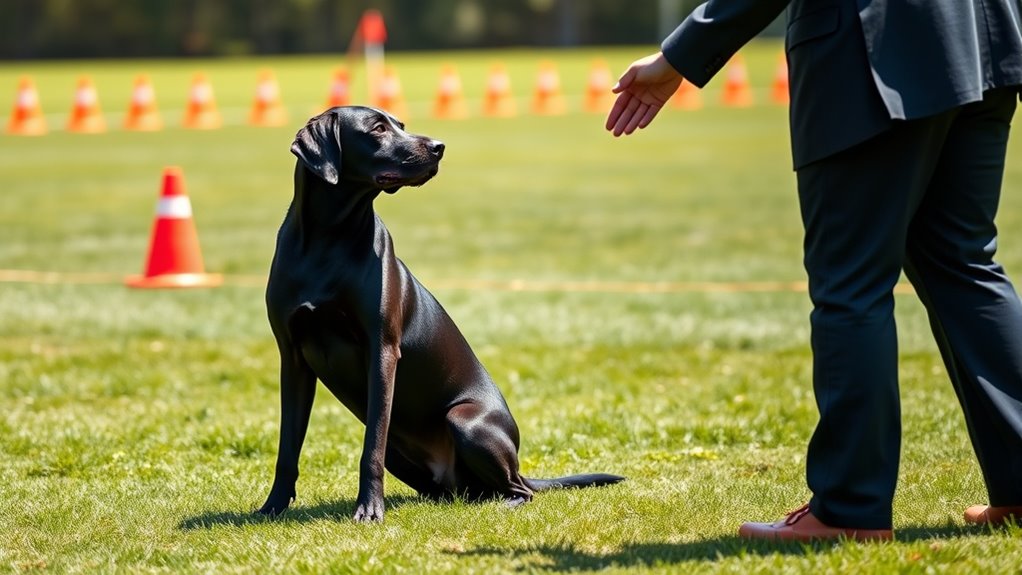
Practicing pattern drills and sequences is essential for building your dog’s confidence and consistency in obedience routines. Repetition helps your dog understand expectations, while pattern variation keeps them alert and adaptable. Focus on precise reward timing to reinforce correct behavior immediately, strengthening the connection between action and reinforcement. Incorporate diverse sequences to prevent predictability, ensuring your dog remains attentive. To elevate your training, consider these strategies:
Vary routines and reward timing to boost your dog’s confidence, focus, and adaptability during training.
- Vary the order of commands to challenge your dog’s adaptability
- Use different locations or distractions to simulate real trial conditions
- Adjust reward timing to maintain motivation and clarity during complex routines
- Integrate sensory processing activities to enhance your dog’s overall engagement and responsiveness
- Incorporating AI-driven training tools can provide real-time feedback and customized training plans.
Enhancing Focus and Handler-Dog Communication
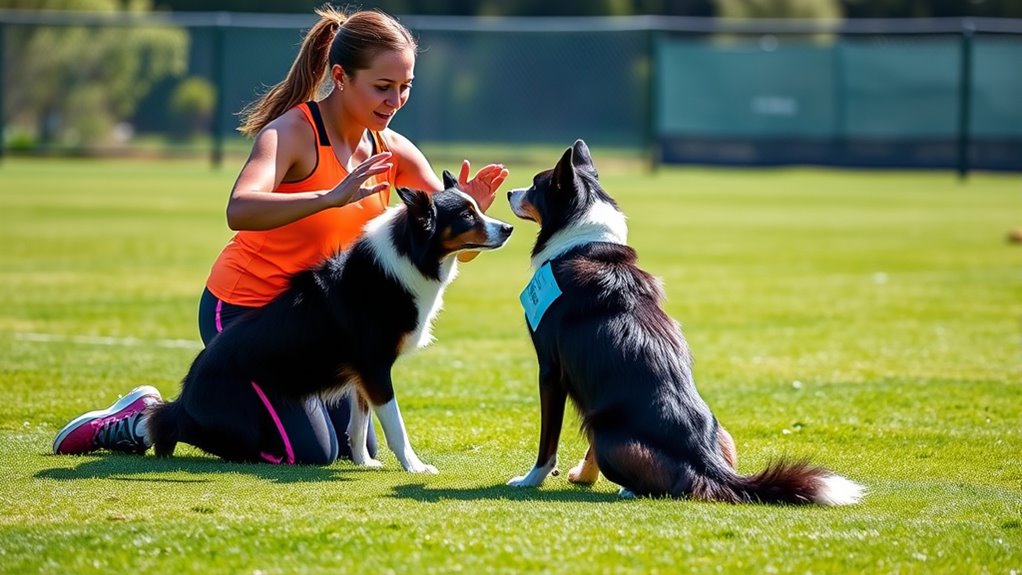
Building strong focus and clear communication between you and your dog lays the foundation for successful obedience training. To improve handler communication, incorporate focus exercises like eye contact drills and attention games. These exercises help your dog learn to prioritize your commands and stay engaged. Use consistent cues and positive reinforcement to reinforce your expectations. During training, minimize distractions to encourage your dog’s focus on you. Practice short, frequent sessions that emphasize maintaining attention before progressing to more complex tasks. By sharpening focus and refining handler communication, you’ll create a solid partnership, making commands more effective and responses more reliable. This foundation boosts your dog’s confidence and ensures smoother performance in competition, setting the stage for success in the ring.
Preparing Mentally and Physically for Competition Day
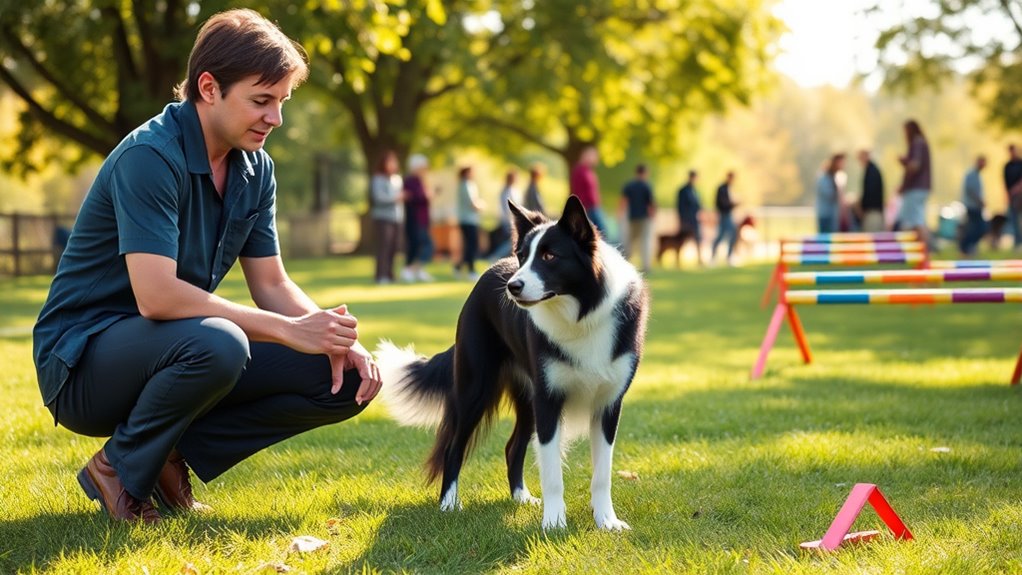
Preparing yourself both mentally and physically for competition day is essential for peak performance. You need to enter the ring confident and focused, which starts with effective calming techniques like deep breathing or visualization. Prioritize nutritional strategies that sustain your energy, such as balanced meals and hydration, to keep your mind sharp and your body alert.
To optimize your preparation, consider the following:
- Practice calming techniques regularly leading up to the event to reduce anxiety.
- Plan your meals and snacks, emphasizing easily digestible, nutrient-dense foods.
- Maintain a consistent sleep schedule to ensure you’re well-rested and alert.
Tips for Successful Ring Performance
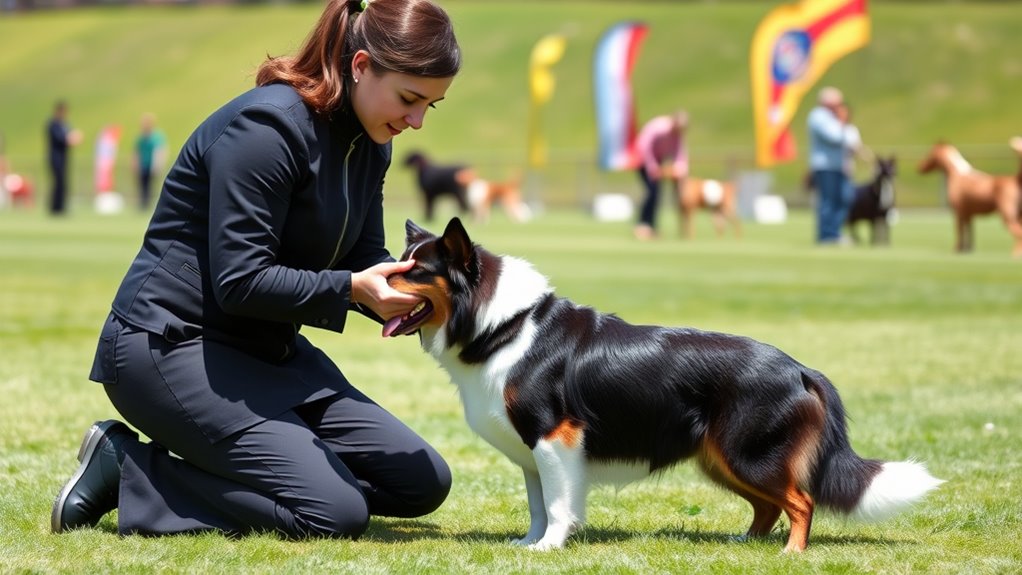
On competition day, your focus should be entirely on executing your training with confidence and precision. Stay calm and trust in the work you’ve done, maintaining clear communication with your dog. Successful ring performance relies on consistent cues and smooth movements, much like dog agility courses, where agility and timing are vital. Confirm your dog’s canine nutrition has been excellent; a well-fed, energized dog performs better and stays focused. Keep your own nerves in check by taking deep breaths and sticking to your routine. Avoid distractions and stay present in the moment, reinforcing the bond with your dog. Remember, your confidence and preparedness directly impact your dog’s performance, so stay positive and enjoy the experience.
Frequently Asked Questions
How Do I Select the Right Competitive Obedience Trial for My Dog?
When selecting a competitive obedience trial, you should consider trial eligibility and breed suitability. Guarantee your dog meets the eligibility requirements, such as age and training level. Also, choose a trial suited to your breed’s natural instincts and abilities, as some breeds excel in specific categories. Research different events, talk to organizers, and pick a trial where your dog can perform confidently and enjoy the experience.
What Are Common Mistakes to Avoid During Training for Competition?
Think of training your dog as building a sturdy bridge; every mistake can weaken it. To avoid obedience pitfalls, steer clear of inconsistent commands and rushing progress. Training errors like neglecting proper reinforcement or not practicing in different environments can hinder your dog’s readiness. Stay patient, consistent, and attentive to your dog’s signals. This way, you’ll create a strong, reliable connection that stands the test of any competition.
How Important Is Temperament Testing Before Entering Trials?
Temperament testing is essential before entering trials because it helps you assess your dog’s breed suitability and behavior in high-pressure situations. By following proper testing procedures, you identify any issues that could affect performance or safety. Knowing your dog’s temperament ensures you’re making an informed decision, so you can focus on training effectively and confidently, ultimately increasing your chances of success in competition.
What Equipment Is Essential for Training and Competing Effectively?
When training and competing, you need essential equipment like a sturdy leash, collar, and treat pouch. Using effective training techniques, you’ll reinforce commands and build focus. Remember, equipment maintenance is key—regularly check for wear and tear to guarantee safety. Proper gear helps your dog perform at their best, making training sessions smoother and competition more successful. Invest in quality tools and keep them in top condition for consistent results.
How Can I Manage Nerves and Stay Calm During the Competition?
You can manage nerves and stay calm by practicing breathing exercises and visualization techniques before and during the event. Focus on slow, deep breaths to reduce anxiety and clear your mind. Visualize successful performances to boost confidence and create a positive mindset. Remember, staying present and trusting your training helps you perform at your best. With consistent practice, you’ll feel more composed and in control when it counts.
Conclusion
As you prepare for competition, remember that training is your ship’s compass, guiding you through the stormy seas of the ring. Stay consistent, adapt to distractions, and sharpen your communication. With patience and dedication, you’ll navigate each obstacle with confidence. When you step into the ring, you’re not just showing your dog’s skills — you’re showcasing the harmony you’ve built together. Trust your training, and let your partnership shine like a lighthouse in the night.

